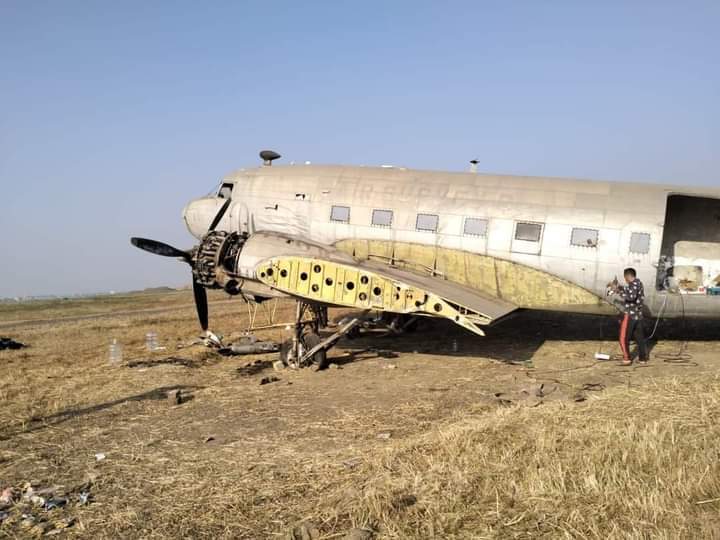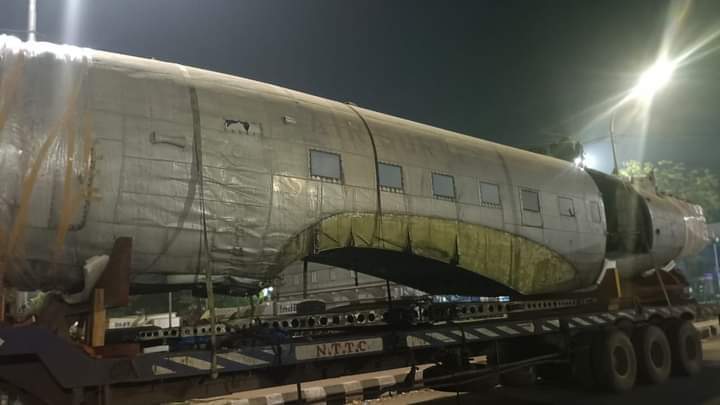
The homecoming of Biju Patnaik’s Dakota, a symbol of Odia pride
The 8-tonne and 65-foot-long aircraft, bearing registration number VT-AUI, was lying abandoned in a remote corner of Kolkata’s Netaji Subhash Chandra Bose International airport for 55 years

Finally, the iconic Dakota (DC-3) aircraft flown by legendary aviator and former Odisha Chief Minister Biju Patnaik has found a new address — Bhubaneswar’s Biju Patnaik International Airport (BPIA). Just a few hundred metres separate the aircraft’s new home and the late commander’s house, Naveen Niwas.
The 8-tonne and 65-foot-long aircraft, bearing registration number VT-AUI, was lying abandoned in a remote corner of Kolkata’s Netaji Subhash Chandra Bose International airport for 55 years. It took its first flight in February 1944.
Heroic tales
The heroic tales of Biju Patnaik, the pilot, and the Dakota aircraft he flew are an inseparable part of the illustrious history of Indian aviation.
Last week, as three trucks carried the dismantled aircraft to Bhubaneswar, hundreds of people lined up on either side of the Kolkata-Bhubaneswar national highway to witness history in motion.
Biju’s son and Odisha Chief Minister Naveen Patnaik welcomed the aircraft by showering petals on it at the Bhubaneswar airport.
Also read: Biju Patnaik’s Dakota aircraft to leave Kolkata for Bhubaneswar memorial
“I am happy that the Dakota flown by Biju Babu has reached Bhubaneswar. He had undertaken several daring operations with this aircraft,” Naveen said.
“His most daredevil act was the rescue of Indonesian freedom fighters from the control of Dutch forces. My mother Gyan Patnaik was the co-pilot of Biju Babu on that Dakota,” he added.
On display from March 5
The aircraft will be displayed for public viewing from March 5, Biju’s birth anniversary. The Airports Authority of India (AAI) has allotted 1.1 acres of land for this purpose at the airport.
According to BPIA Director Prasanna Pradhan, repair works are underway at the state government hangar in the airport. Following the repairs, the aircraft will be taken to the allotted space at the airport and reassembled before being installed on a pedestal for display.
The Odisha government has entrusted Bhubaneswar-based Aerospace Research and Development Center the job for its repair and installation at a cost of Rs 3 crore. The company also looked after the transportation of the aircraft from Kolkata to Bhubaneswar.

Before joining politics, Biju had in 1947 formed Kalinga Airlines with its base in Calcutta. He was the airlines’ chief pilot.
This aircraft was part of the erstwhile Kalinga Airlines’ fleet of 16 Dakotas which carried soldiers into Kashmir, landing platoons of troops in Srinagar. Kalinga Airlines’ DC-3s were also used to drop supplies in north-eastern India.
In 1953, Kalinga, along with other seven independent domestic airlines — Deccan Airways, Airways India, Bharat Airways, Himalayan Aviation, Indian National Airways, Air India and Air Services of India — was nationalized and merged into Indian Airlines Corporation.
The Dakotas had many affectionate nicknames. The Americans called it the Gooney Bird, Old Fatso, Skytrooper, Placid Plodder, Dizzy Three and Tabby. While the British airmen called it the ‘Dak’, the Royal Canadian Air Force called it ‘The Flying Elephant’. The French called it ‘The Beast’. Biju Patnaik used the term ‘Gooney Bird’ for the Dakotas.
Daredevil act
In 1946, Biju was asked by Jawaharlal Nehru to help the Indonesian freedom fighters and their cause by ferrying planeloads of medicines and humanitarian assistance. Along with his pilots, Biju flew numerous sorties, evading the Dutch who had put up land and sea blockades. The planes would fly from Calcutta with fuel stops at Mohanbari and Singapore.
On July 21, 1947, at the behest of Nehru, the 32-year-old Biju, along with his co-pilot and wife Gyan, leaving behind their 14-day-old son, took off on an old Dakota to Singapore enroute Jakarta. In Singapore, he received a message from the Dutch, threatening to shoot down his aircraft if it entered Indonesian airspace.
An unruffled Biju replied: “Resurgent India does not recognize Dutch colonial sovereignty over the Indonesian people. If my aircraft is shot down, every Dutch plane flying across the Indian skies will be shot down in retaliation.” He also dashed off a short message to Nehru: “Take necessary steps should my aircraft be shot down.”
In a dare-devil rescue act, the ace pilot, landing on an improvised airstrip and using leftover petrol from abandoned Japanese military dumps, eluded the Dutch to land in Jakarta. On July 24, he flew out Indonesian Vice-President Md Hatta and Prime Minister Sutan Sjahrir and landed in Delhi.
For his act of bravery, Biju, who was a personal friend of the Indonesia’s first president Sukarno, was honoured with ‘Bhoomi Putra,’ the highest Indonesian award.
Homecoming
The Dakota’s homecoming has brought a sense of satisfaction to researcher and an ardent Biju fan, Anil Dhir.
Dhir, who has authored a book on the legendary leader, had urged the Odisha government multiple times to bring the aircraft back to Bhubaneswar.
According to Dhir, also a trained pilot, this particular aircraft (DC-3) VT-AUI was not used to rescue the Indonesian leaders.
“I am really happy; the aircraft is a symbol of Odia Pride. I personally inspected the plane and confirmed its registration. Many friends, especially the late Airports Authority of India Chairman, Guruprasad Mohapatra, who unfortunately passed away due to Covid-related complications in 2021 had extended all cooperation,” Dhir, told The Federal.
Dhir says that Biju babu had leased this aircraft from Air Survey India and operated for 27 months under the Kalinga Airlines banner. It was a transport plane with no seats and Biju babu flew it on supply missions to the North East. The plane was also engaged in the Indian Post airmail services and flew daily from Kolkata to Nagpur and back. The aircraft had made many landings at Bhubaneswar airport.
The maverick leader
The maverick Biju loved adventures. In 1932, he had cycled all the way from Cuttack to Peshawar on ‘Visit India Mission’ to spread the message of humanity. He dropped out of Cuttack’s Ravenshaw College and joined as a trainee pilot in the Royal Indian Air Force at the beginning of Second World II. During World War II, he rescued several British families that were imprisoned by the Japanese. He also clandestinely flew Indian freedom fighters from one location to another.
Also read: How Kalam’s chat with Biju Patnaik gave wings to India’s missile dreams
Ex-IAS officer Aurobindo Behera, who was secretary to Biju during his second stint as chief minister, remembers how at times his boss would be in an expansive mood and share a few of his flying incidences.
Behera recalls that Biju used to say that during his days as a pilot, flying was an adventurous and exciting affair as instrumentation was not that developed and the pilot had to apply his skills and experience while taking off, landing or navigating through rough weather.
“Once, he narrated that while flying over the mountainous terrains in eastern Uttar Pradesh, his Dakota aircraft developed a snag. It ultimately crashed, leading to an assumption that Biju had died. However, he had safely ejected. Walking through the rough terrain, he boarded a train and, much to everyone’s relief and surprise, landed in Delhi,” recounted Behera. “While narrating his tales, a sense of satisfaction and pride was evident on his face,” added the former bureaucrat.


